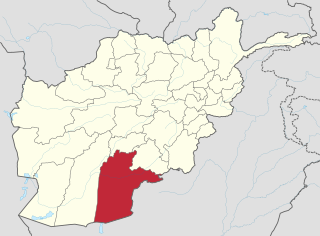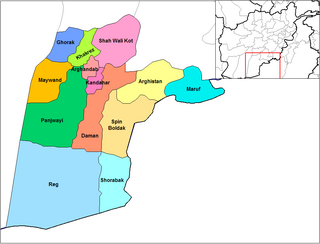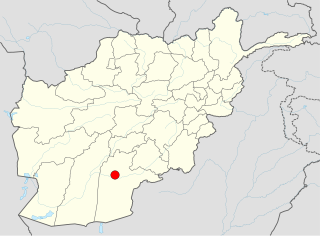Related Research Articles

Kandahar is a city in Afghanistan, located in the south of the country on the Arghandab River, at an elevation of 1,010 m (3,310 ft). It is Afghanistan's second largest city after Kabul, with a population of about 614,118. It is the capital of Kandahar Province as well as the headquarters of the Taliban, formally known as the Islamic Emirate of Afghanistan. It is also the centre of the larger cultural region called Loy Kandahar.

Farah is one of the 34 provinces of Afghanistan, located in the southwestern part of the country next to Iran. It is a spacious and sparsely populated province, divided into eleven districts and contains hundreds of villages. It has a population of about 563,026, which is multi-ethnic and mostly a rural tribal society. Farah's population is dominated by Pashtun (80%) tribesmen although Tajiks and a small minority of Shi'a Hazaras can also be found in the countryside. The Farah Airport is located near the city of Farah, which serves as the capital of the province. Farah is linked with Iran via the Iranian border town of Mahirud. The province famous tourism sites include Pul Garden, New Garden, Kafee Garden, shrine of Sultan Amir and Kafer castle are from sightseeing places of Farah province

Kandahār is one of the thirty-four provinces of Afghanistan, located in the southern part of the country, sharing a border with Pakistan, to the south. It is surrounded by Helmand in the west, Uruzgan in the north and Zabul Province in the east. Its capital is the city of Kandahar, Afghanistan's second largest city, which is located on the Arghandab River. The greater region surrounding the province is called Loy Kandahar. The Emir of Afghanistan sends orders to Kabul from Kandahar making it the de facto capital of Afghanistan, although the main government body operates in Kabul. All meetings with the Emir take place in Kandahar, meetings excluding the Emir are in Kabul.

Panjwayi is a district in Kandahar Province, Afghanistan. It is located about 35 kilometres (22 mi) west of Kandahar. The district borders Helmand Province to the southwest, Maywand District to the west, Zhari District to the north, Arghandab, Kandahar and Daman districts to the east and Reg District to the south. Panjwayi was reduced in size in 2004 when Zhari District was created out of the northern part of it, on the northern side of the Arghandab River, which now forms the northern boundary.

Dadullah was the Taliban's most senior military commander in Afghanistan until his death in 2007. He was also known as Maulavi or Mullah Dadullah Akhund. He also earned the nickname of Lang, meaning "lame", because of a leg he lost during fighting.
The 2008 Kandahar bombing of February 17, 2008 in Kandahar, Afghanistan, was an attack targeting a crowd of people watching a dog-fighting competition. With more than 100 killed, it was the deadliest attack on Afghan soil since 2001.
Shakiba Matin Hashemi is an Afghani politician who was elected to represent Kandahar Province in Afghanistan's Wolesi Jirga, the lower house of its National Legislature, in 2005.
Operation Dragon Strike was a NATO counter-insurgent mission in Kandahar province, Afghanistan, against Taliban forces, which started on September 15, 2010.
The Jabal al-Zawiya massacres took place on 19–20 December 2011, in the Idlib province of Syria during the 2011-2012 Idlib Governorate clashes between the Syrian Army and opposition forces, within the larger scope of the 2011-2012 Syrian uprising. Human rights and opposition activists said that some 200 people were killed by Syrian security forces in the hills and villages of the north-western province of Idlib on 19 and 20 December 2011. The Syrian state news agency claimed that 1 terrorist was killed and several more wounded.
Alkozai is a village in Panjwayi District, Kandahar Province, Afghanistan.
Balandi is a village in Panjwayi District, Kandahar Province, Afghanistan.

The Kandahar massacre, also called the Panjwai massacre, was a mass murder that occurred in the early hours of 11 March 2012, when United States Army Staff Sergeant Robert Bales murdered 16 Afghan civilians and wounded six others in the Panjwayi District of Kandahar Province, Afghanistan. Nine of his victims were children, and 11 of the dead were from the same family. Some of the corpses were partially burned. Bales was taken into custody later that morning when he told authorities, "I did it".
The following lists events that happened during 2015 in Afghanistan.
2021 (MMXXI) was a common year starting on Friday of the Gregorian calendar, the 2021st year of the Common Era (CE) and Anno Domini (AD) designations, the 21st year of the 3rd millennium and the 21st century, and the 2nd year of the 2020s decade.

The Kulchabat, Bala Karz and Mushkizi massacre was an alleged war crime reportedly perpetrated by the Soviet Army on 12 October 1983 in the villages of Kulchabat, Bala Karz and Mushkizi in the Kandahar Province, Afghanistan, during the Soviet–Afghan War. Reports indicate that up to 360 people were gathered at the three village squares and shot, including 20 girls and over a dozen older people.
War crimes in Afghanistan covers the period of conflict from 1979 to the present. Starting with the Soviet invasion of Afghanistan in 1979, 40 years of civil war in various forms has wracked Afghanistan. War crimes have been committed by all sides.
References
- ↑ "How it happened: Massacre in Kandahar". BBC News . BBC. 2012-03-11. Retrieved 2012-03-11.
